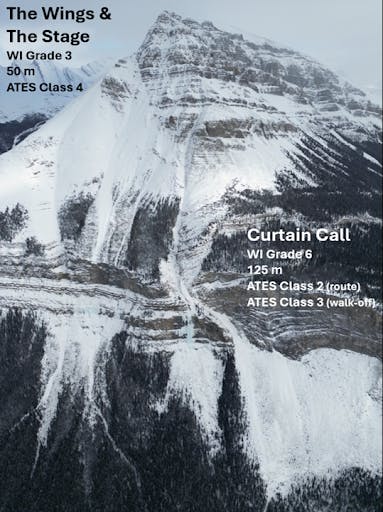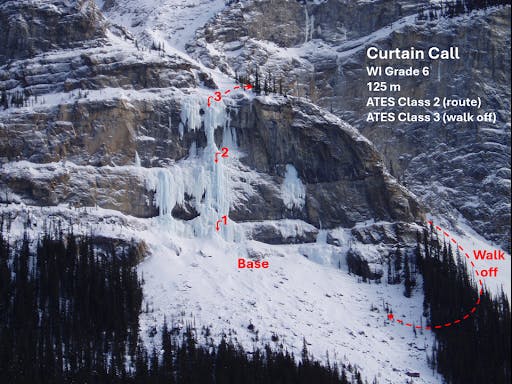
The Wings and the Stage and Curtain Call are neighbouring climbs on Tangle Ridge.
Curtain Call
110 m WI6
ATES 2 (Challenging)
The Wings and the Stage
WI3
ATES 4 (Extreme)
Curtain Call is a classic difficult ice climb with an often-challenging and overhanging last pitch. Ice fall is a big hazard on this route.
The Wings and The Stage is a one-pitch area to the left of Curtain Call.
These climbs are located on the east side of the Icefields Parkway, about 14 km north of the Icefields Visitor Centre. They are visible from the highway.
Popularity
- 33 people completed the survey
- 31% climbed here one time
- 41% climbed here 2–5 times
- 28% climbed here six or more times
Avalanche Frequency
- 44% of respondents have never seen any avalanche debris on the climb or the approach
- 41% have seen debris less than half the time they climbed the route
- 13% have seen avalanche debris more than half of the time
Debris Location
- 63% of respondents saw debris on the approach
- 63% saw it at the base of the climb or lower
- 32% saw it above the last pitch
User Observations on Avalanche Debris:
- "Runout approximately 75 m long, depth of about 50 cm."
- "Observed runout 10–15 m, always below the route."
- "Most of the debris is usually ice, but sometimes the weight of the ice fall causes the slopes underneath to step down to the weak layers. Typically, length has been less than 30 m and depth less than 1 m."
- "Observed runout covering two-thirds of the slide path. Depth unknown."
- "I have seen debris below the climb, above in the gully when we crossed up high once, and I have seen debris to the valley from that big gully."
- "Clearly, the Wings and the Stage and Curtain Call sit squarely in avalanche runout paths. The large shallow gully above the stage tends to funnel things to the left of centre of the Stage. However, in normal to heavy snow years, the entire runout zone below the Wings and the Stage can be covered with debris—typically occurring late season (i.e., climax slides). The rightmost Wing seems to present as the safest line of the group. In contrast to that is Maarten’s new line, which is above the leftmost Wing (depending on who you talk to) and is in a very obvious path. On all the Wing and the Stage routes, debris depth can be over 2 m. For Curtain Call, depth and size can vary significantly—up to 2 m well into the scrub trees, to 30 cm depth on smaller avalanches that run 60m or less from the base of the route."
- "Observed debris from a size 2 natural avalanche from above. Depth was only HST (height of snow), but it went down to the flat, with a distance of 100–150 m."
- "Saw full spring runout avalanche debris to the lowest part of the treeline, climber's centre/left."
- "It was snow covered so it was hard to tell size. Probably ran three quarters the length of the slope below, over 50 m width."
- "I've seen older debris about half the time, mostly about 100m or more below the climb. Have roped up regularly to traverse into the start."

Avalanche Observations
- 13% have witnessed an avalanche in the area
- 87% have never witnessed an avalanche in the area
Trigger
- 100% of respondents say the avalanche was triggered naturally.
Contributing factors
- 29% of respondents believe that new snow amounts contributed to the avalanche
- 43% winds
- 43% significant warming
- 14% cornice or rockfall
Start Zone
- 33% of respondents say it started well above the climb
- 33% say it started right above the climb
User Observations on Avalanches and Incidents
- "Avalanche caused by new snow and winds in the start zone above Wings and the Stage, running over climb."
- "The Wings and the Stage and Curtain Call all get significant sun on spring weekends. We were parked on the highway in the afternoon on the Easter weekend on a sunny warm day. Several heat-induced slides poured over the Stage and Wings in rapid succession. These tore the snowpack to the ground above the climbs. The snow above Curtain Call did not release. This was the day of the Jeff Lakes picture where he was hitchhiking with a wood axe over his shoulder in Chic Scott’s book. The whole affair was rather amusing."
- "I hit the avalanche at pitch 2 when we were rappelling. Powder clouds went down to the flat."
- "Caused by spring conditions and warm solar radiation."

Summary
- "Most of the close calls my friends and I have had in the area have been from falling ice."
- "I have seen more debris on the Wings and the Stage approach than on Curtain Call. However, we have all observed the shattered and tangled trees on the approach to Curtain Call which is a very stark reminder of the fact that large slides pour over the route. There has been debris in the walk off from Curtain Call semi -regularly. Also note that JoJo identifies the Stage as the middle ice and the Wings as the more sheltered ice to the right. The ice to the left has often been referred to as the left Wings – as mentioned above."
- "There are start zones above Curtain Call, but the terrain features above the climb appear such that smaller avalanches would be funneled to the looker's right of the climb. Larger avalanches could jump the terrain feature protecting Curtain Call so I would still evaluate conditions before climbing this route."
- "I’ve seen debris as well below the Wings and the Stage, from the slope above. Also, there’s another gully further left (where we climbed Tangled Up in Blue this year), which drains that whole side of the face and I’ve seen debris there often over the past few years."
- "The walk off to climbers right (does anyone use that anymore?) is the most dodgy area in my opinion. Other active start zones seem to be above the climbing where not many climbers actually go. Most of the debris I've seen has been from near the base of the climb, partway down the approach."
- "Curtain Call has a history of catastrophic collapse of the upper pillar."
- "The descent gully sometimes used on the climber's right of the route is very active for avalanches. I have heard activity and seen debris frequently from that area. It is a dangerous option for descending the route."
- "Looks like the gully right of the climb is the more serious avalanche path."